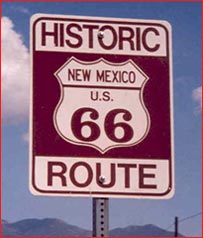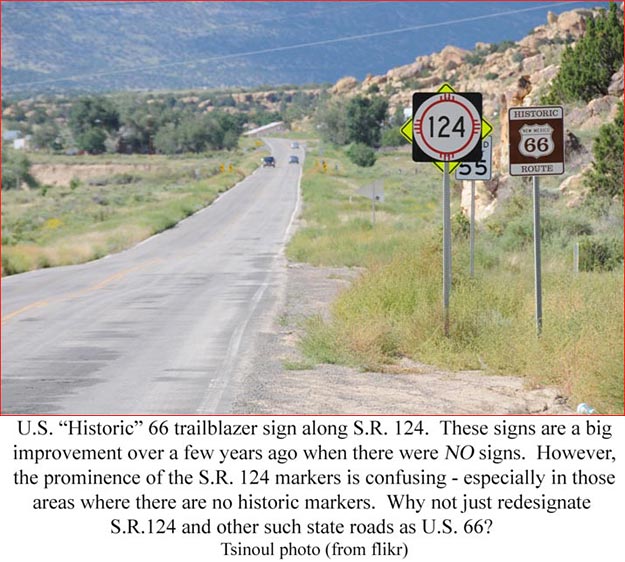 The renaming of several little known New Mexico state highways and Interstate
"Business Loops" as U.S. 66 along with the renaming of connecting portions of I-40 as a jointly named I-40/U.S. 66 would provide Route 66 travelers with a well-signed, seamless route across The Land of Enchantment.
The renaming of several little known New Mexico state highways and Interstate
"Business Loops" as U.S. 66 along with the renaming of connecting portions of I-40 as a jointly named I-40/U.S. 66 would provide Route 66 travelers with a well-signed, seamless route across The Land of Enchantment.
Once travelers reach the Land Of Enchantment, there can be no doubt that they have entered the glorious Southwest. Many beautiful mountain ranges can be seen across the landscape. In some areas dry, desert conditions typified by sagebrush stand in contrast to stands of cedar, juniper and piņon pines at higher elevations and lush forests of ponderosa pine and aspen at the still higher elevations.
The Land of Enchantment is rich in Native American culture and history, some of which goes back thousands of years. During Route 66's heyday, many a westward bound traveler would stop and buy Native American jewelry, pottery, rugs, kachina dolls or other items at roadside establishments along U.S. Route 66. It can be said that there is something truly "magic" about Route 66 that appeals to all different ethnic groups and people from all walks of life. Its ribbons of asphalt are like a central cultural thread that connects us all.
In New Mexico there are over 260 miles of post 1937, pre-Interstate era Route 66 that remain drivable. In a number of places, the old road is still designated as a state highway but no longer as Route 66.
 In 2004 the State of New Mexico became the first of the eight Route 66 states to have their portion of the historic Route designated as a National Scenic Byway. Byway status has helped focus attention on the Route and furthered preservation efforts in the state.
In 2004 the State of New Mexico became the first of the eight Route 66 states to have their portion of the historic Route designated as a National Scenic Byway. Byway status has helped focus attention on the Route and furthered preservation efforts in the state.
With the coming of the Scenic Byway, brown and white historic Route 66 markers began to dot the way. This was a big improvement over the earlier years following the "decommissioning" of U.S. 66 when there were NO signs. Unfortunately, in many areas such commemorative historic markers are not extensive enough to assist travelers in finding and staying on Route 66. Particularly onerous are those areas where the Route is now designated as some other state highway number such as New Mexico 333. This can cause motorists to wonder if they're really for sure on Route 66 especially if some of the historic markers are missing.
Another serious issue is that the Route 66 Scenic Byway is not continuous from state line to state line but is found in a number of disjointed, disconnected segments. This forces the Route 66 motorist to enter I-40 when they come to the end of one Byway segment and follow I-40 until they reach the next Byway segment. While the motorist is on I-40 there are frequently NO Route 66 markers. This completely destroys any reasonable resemblance of continuity and is just plain unacceptable.
According to a research study done by Rutgers University, the difficulty of finding and staying on Route 66 - the direct result of inadequate signage - is the number one complaint of Route 66 travelers.
In an effort to address these issues, The Route 66 Recommissioning Initiative advocates and supports the renaming of the following roads and highways as a new U.S. Route 66:
New Mexico State Route (SR) 117, SR 118, SR 122, SR 124, SR 333, "Business Loop" I-40, Tucumcari Blvd, Will Rogers Drive (Santa Rosa) and Central Avenue. Or, more simply put, all those sections of Old Route 66 currently designated as Scenic Byway.
Renaming the connecting Interstate in between these roads as a new jointly named I-40 and U.S. 66 would give motorists a continuous, uninterrupted U.S. Route 66 across the State of New Mexico. (see The Plan).
It's important to remember that the Route 66 Recommissioning Initiative is a renaming and resigning proposal and NOT a "highway construction plan". All Historic Route 66 markers would remain in place and be maintained. The intent of The Initiative is to ADD signs and not simply replace any existing signs. Clearly, travelers want and expect to see both U.S. Route markers and "Historic" markers therefore the need for both is clear.
The new U.S. Route 66 must also comply with all existing Byway guidelines and criteria in those locations where the new U.S. 66 would share the road the Scenic Byway.
Adding a U.S. Route designation would spur further improvements in signage, put the "66" icon back on standard online and printed atlases and provide historic Route 66 travelers with a consistent, continuous, state-to-state marking plan. This would in turn make Route 66 more "visible" and "user-friendly" to the casual traveler thus luring new traffic to the old road. A larger traffic base will without doubt provide a significant boost to the economic fortunes of historic and newer roadside businesses giving them a more prosperous future. Many older establishments will be able to stay in business for the function for which they were originally intended.
Concerning the pre-1937 Santa Rosa - Santa Fe - Albuquerque - Los Lunas route, the most ideal proposal there would be to designate it as a new U.S. "Alternate" 66 (or U.S. 66A). This would provide the Route 66 traveler with an alternative. Travelers could elect to go west on one route and back on the other or visa versa. Another option might be to assign the pre-1937 route no U.S. Route designation but instead greatly beef up and enhance the historic signage to the so that they can function like the route markers found on other state highways.
All U.S. Routes are managed entirely by the American Association of State Highway and Transportation Officials (AASHTO). AASHTO policy clearly states that "Notwithstanding established policies, AASHTO recognizes that Congress on occasion will establish highway routes, specifying the location of the route as well as designating the route number(s) to be used".
Residents of New Mexico are at somewhat of an advantage here in that New Mexico Senator Tom Udall has a seat on the Senate Transportation committee. Interested New Mexico residents should contact Senator Udall and urge him to consider including the renaming of Route 66 in any upcoming transportation authorization. Urge him to include federal funds to pay for the new signs and any other related expenses that the State Highway Department might incur.
Contact Senator Udall at: http://www.tomudall.senate.gov/?p=contact
Interested New Mexico residents should also contact their Congressional Representative at: http://house.gov/writerep/
Let your U.S. representative know that a new official U.S. Route designation is needed for Old Route 66 and that federal assistance is needed to help pay for additional new signs and, where needed, repairing the old roadway and bridges in a manner that will preserve the Route's historic appeal.
It might also be of some benefit to contact the State Department of Transportation and let them know that Route 66 needs to be put back and signage improved. Contact the Department through http://dot.state.nm.us/Contact.html

|















